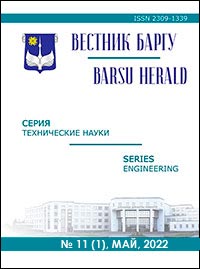ВЛИЯНИЕ МАГНИТНО-ИМПУЛЬСНОЙ ОБРАБОТКИ НА ФАЗОВЫЕ ПЕРЕХОДЫВ ПОВЕРХНОСТНОМ СЛОЕ РЕЖУЩЕГО ОСЕВОГО ИНСТРУМЕНТАИЗ ИНСТРУМЕНТАЛЬНОЙ СТАЛИ
Ключевые слова:
магнитно-импульсная обработка; сверло; остаточный аустенит; фазовые переходы; микротвердость; режущий инструмент; сталь Р6М5; сталь Х6ВМФАннотация
Исследовалось влияние магнитно-импульсной обработки осевого режущего инструмента из инструментальных сталей Р6М5 и Х6ВМФ на их структуру, фазовый состав и микротвердость. Обнаружено аномально высокое содержание остаточного аустенита в режущей кромке сверла из стали Х6ВМФ. Показано, что в результате магнитно-импульсной обработки сверла из стали Х6ВМФ количество остаточного аустенита в режущей кромке уменьшилось от Vγ = 78 % до Vγ = 62 %, а микротвердость поверхности увеличилась от 550 до 830 HV 0,025. Установлено, что магнитно-импульсная обработка сверл из стали Р6М5 приводит к незначительному уменьшению количества остаточного аустенита в режущей кромке сверла и увеличению микротвердости кромки от 660 до 750 HV 0,01. Установлено, что наложение магнитного поля в процессе магнитно-импульсной обработки сталей приводит к смещению температуры начала мартенситного превращения, что сопровождается снижением количества аустенитной фазы в сталях и увеличением их микротвердости. Воздействие давления магнитного поля на поверхность обрабатываемого инструмента приводит к деформации обрабатываемого материала, что также может сопровождаться эффектом деформационно-активированного γ -> α превращения и упрочнением стали.
Рис. 2. Табл. 2. Библиогр.: 16 назв.
Загрузки
Опубликован
Выпуск
Раздел
Лицензия
Copyright (c) 2023 Вестник БарГУ Серия "Технические науки"
Это произведение доступно по лицензии Creative Commons «Attribution-NonCommercial» («Атрибуция — Некоммерческое использование») 4.0 Всемирная.
Авторы сохраняют за собой право заключать определенные договорные соглашения, касающиеся неисключительного распространения опубликованной версии работы (например, размещать ее в институциональном репозитории, публикация в книге) со ссылкой на ее первоначальную публикацию в этом журнале.





